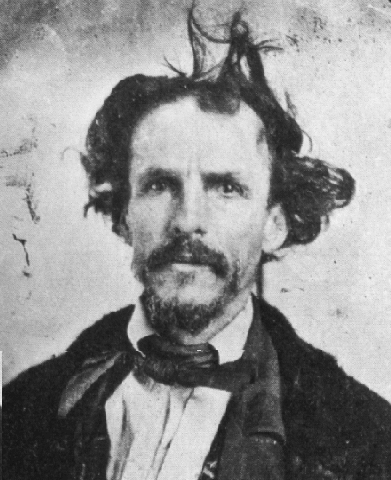A few days ago when I included a graphic showing two rows of old soldiers standing in front of a meeting hall at Republic and asked what’s wrong with this picture, I was hinting at the two Civil War veterans who showed up wearing pith helmets. Dave Lovewell found something else peculiar about the photograph. He thought it looked as if an earlier likeness of Thomas Lovewell had been Photoshopped into the back row of the Civil War reunion. Dave’s great-grandfather simply looked too young to be part of this group.
When Thomas signed up with Thomas Ketcham’s “A” Company of 3rd California Infantry at his first opportunity to enlist in September 1861, he gave his age as 35. Since men as young as 18 were legitimately joining the Army, and boys a few years younger than that were lying about their birth dates in order to fight to preserve the Union and exterminate slavery, shouldn’t Thomas have been one of the older veterans in the photo? In fact, he was. As we should expect of a group of veterans getting together two decades after the end of the war, most of the men in the picture were in their 40’s. One or two were were their 30’s. Post Commander R. T. Stanfield was 39, 20 years younger than Thomas Lovewell, who, when the picture was taken of the group assembled on a porch in Republic City, was five months away from turning 60.
Of course, men older than Thomas Lovewell had joined the Union Army during the war. A few years after Thomas’s father-in-law Vinson Perry Davis succumbed to the pellets of lead shot embedded in his lung, Vinson’s widow married William Scott, a veteran of the 37th Iowa Volunteer Infantry, the “Graybeard Regiment.” The 37th welcomed recruits between the ages of 45 and 60, who, like the Invalid Corps, were expected to tackle non-combat duties and free up younger men for the real fighting. When he enlisted, William Scott was 45.
In going through G.A.R. records to learn the ages of the men gathered on the streets of Republic City in 1885, I discovered something else quite unexpected. There is a story behind the photograph that’s been featured on this site for almost two years now. Thomas Lovewell was not all spruced up to visit a neighboring burg that day in late July - he was courting a new G.A.R. post. Perhaps we should say, it was courting him. His own White Rock Valley Post No. 211, formed in 1883 with 12 charter members including Thomas Lovewell, William Scott, and Willard Woodruff, like its host town, quickly shriveled on the vine. Listed on the roll as S.V.C. (Senior Vice-Commander) or O.G. (Officer of the Guard), Thomas seems to have jumped ship before the end came in June 1885, a month before the trip to Republic City, when White Rock Valley was forced to surrender its charter.
Whatever Thomas Lovewell was looking for in a veterans’ group, he did not find it at Republic City. What we see in the photograph is not just the record of a regularly-scheduled meeting on the last Saturday in July, but something closer to Rush Week at a frat house. We may not be able to attach names to those hoary beards lined up on a porch because the men wearing them were not bona fide members of Billy Hughes Post No. 310, merely candidates who decided finally that they could not afford to ante up the quarterly dues required. Like the White Rock Valley Post, Billy Hughes Post 310 at Republic City would founder. Even Post Commander R. T. Stanfield would look soon elsewhere, drifting toward the John Brown Post at Belleville, before helping to reorganize a unit at Republic in the 1890’s.

As for Thomas, he would attend a G.A.R. emcampment at San Francisco in 1886, the same year he flirted with the idea of relocating his family to Oregon. His restlessness would lead him to make a deal with a railroad and then lay out the village of Lovewell around that coveted depot in eastern Jewell County in 1888. In 1893, when he was 67 years old and about to be reunited with his long-lost eldest daughter (another occasion for getting slicked-up and having his picture taken), Thomas joined Jim Lane Post No. 34 at Mankato.
Named for Senator and Civil War General James Henry Lane, a volatile figure from the days of “Bleeding Kansas” who once killed his neighbor over a boundary dispute and committed suicide after being re-elected to the Senate (he also seldom seemed to enjoy a good-hair day), the post numbered 88 members when Thomas decided to sign on. The ranks quickly dwindled to 48 or so, but despite its inevitable yearly attrition, the Jim Lane Post would hang on to outlive even Thomas Lovewell.